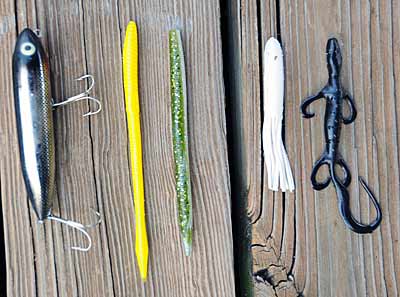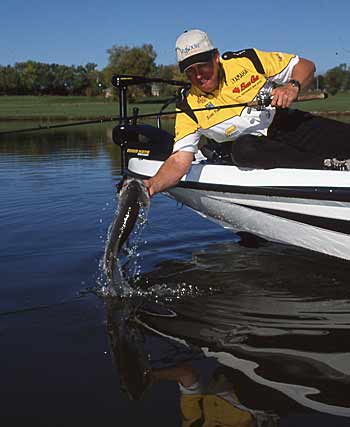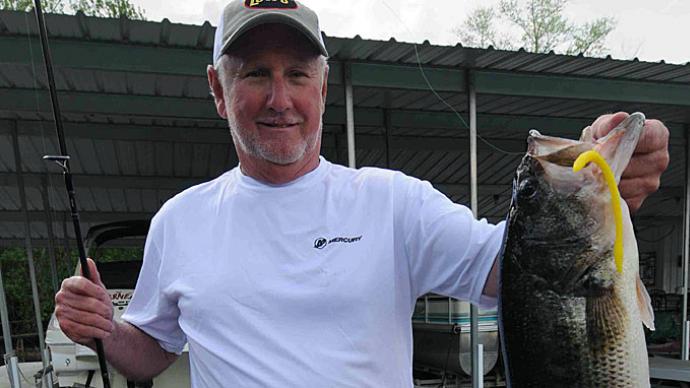
When the spawn is on, bass will attack just about anything you throw near their nests.
However, specific lures are better for locating nesting bass or triggering strikes from wary bass on nests. Nesting bass can be tricked into biting lures worked through different levels of the water column even though their nests are in shallow water. Bass will smash a topwater lure worked along the surface, strike a lure slowly falling past their face, or suck in a bait disturbing the bottom of their nest.
Here are five lures I rely on to catch bass throughout the spawn.
- Walking Topwaters
A Zara Spook is my favorite topwater lure to walk over nesting bass. I walk the lure at a slow, steady pace along an open spawning bank or beside any shallow cover. If a bass slaps at the lure but misses, I let the Spook sit for a second and then start retrieving it again, which usually triggers a strike. If I see a bass following the Spook, I will speed up my retrieve to imitate a baitfish fleeing from its predator, and bass usually react by smashing the lure. If a bass fails to hit the Spook after missing it the first time, I will throw a follow-up soft plastic lure to the fish.
I favor a Spook with rattles or a knocker for fishing in dirty water and a plug without noisemakers for fishing in clear water.
- Floating Worms
My choice is a Zoom Magnum Trick Worm for a subtle topwater presentation in clear water. A floating worm is a misnomer in this situation because the worm sinks from the weight of a hook. However, I can keep the worm on or near the surface by wacky rigging it with a 1/0 Owner Mosquito Hook and steadily twitching the lure to make it rise to the top. Whenever I see bass on a nest, I throw past the nesting fish and try to bring the lure back over the top of the fish. If the bass ignores the worm as it passes overhead, I will let the worm sink down into the nest to make it bite the bait.
Floating worms in bright colors are best for tempting bass on nests. My favorite color is yellow, but bubble gum and white produce strikes.
- Stickworms

The slow fall of a stickworm, such as the Yamamoto Senko, descending into a bass’ spawning bed is one of the most effective ways to catch bass locked on a nest. I wacky rig the Senko weightless with a 3/0 wide gap hook when I want the lure to slowly fall in front of a nesting bass while sight fishing. If the bass ignores the bait on the fall, I let the Senko drop to the bottom and give it a slight twitch to stir up the nest. Twitching the bait on slack line will keep the lure in the nest and eventually cause the bass to pick it up. When I cannot see nests, I wacky rig the Senko on a 1/16- or 3/32-ounce Gamakatsu G Finesse Wacky Head that allows me to twitch the lure steadily along a spawning bank and cover more water quickly until I get a strike.
My favorite Senko colors are green pumpkin, watermelon/red flake, baby bass, or white for clear water and black/blue for stained or murky water.
- Tube Baits
This is the ideal lure for skipping across the surface to imitate shore minnows when bass are nesting. Most strikes from nesting bass occurs on the initial fall as bass react to the lure’s skipping across the top. If the lure fails to produce a bite on the fall, I slowly lift it a couple of inches and then let it drop to the bottom. I will do this several times, reel in the tube, and throw it to another spot.
I use a 4-inch tube rigged on a 1/16- or 1/32-ounce tube jighead for skipping in clear water. My favorite tube bait colors are salt-and-pepper and green pumpkin for skipping, and I will use a white tube when I want to sight fish for a bass locked on the nest.
- Plastic Lizards
I never have any trouble detecting a strike when using this lure during the spawn because bass crush a plastic lizard as it passes through a nest.
The versatility of a plastic lizard allows me to throw it on a Carolina or Texas rig, but my favorite way to use it for spawning bass is on a split-shot rig with spinning tackle. I impale a 6-inch lizard on a 3/0 offset worm hook and add a 1/8- or 1/4-ounce pegged cylinder weight about 18 inches above the lizard for dragging it along pea gravel banks. I pull the lizard about 1 to 2 feet along the bottom and let it sit for a couple of seconds. If this doesn't get a strike, I repeat the process to the boat.
I opt for a black lizard when fishing in murky to stained water. My favorite hues for clear water include red, green pumpkin, or watermelon/red flake.
BassResource may receive a portion of revenues if you make a purchase using a link above.




